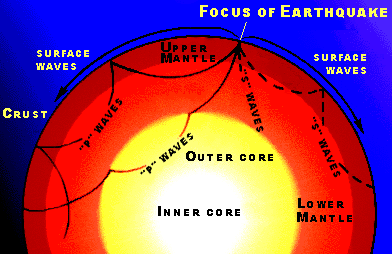
Cross section of the Earth showing the paths of some compression ("P," or primary) and transverse ("S," or shear) waves generated by earthquakes.
The vibrations are of two basic types, compression waves and transverse or shear waves. Since the compression waves travel faster through the Earth, they arrive first at a distant point; they are known as primary or "P" waves. The transverse waves arriving later are referred to as shear or "S" waves. In an earthquake, people may note first a sharp thud, or blast-like shock, that marks the arrival of the P wave. A few seconds later, they may feel a swaying or rolling motion that marks the arrival of the S wave.

Cross section of the Earth showing the paths of some compression ("P," or primary) and transverse ("S," or shear) waves generated by earthquakes.